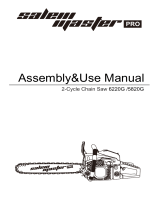
CLEAN FUEL FILTER
To clean fuel tilter, drain your unit by
running dry of fuel, remove fuel cap/re-
tainer assembly from tank. Pull tilter
from tank and remove from line. Clean
with mild detergent and rinse. Dry thor-
oughly, reassemble. _ : ._
CARBURETOR ADJUSTMENT
WARNING: The chain will be moving
during most of this procedure. Wear
your protective equipment and observe
all safety precautions. During the Iowi
speed mixture adjustment recheck idle
speed after each tum of the screw. The
chain must not move at idle speed.
Carburetor adjustment is cdtical and if
done improperly can permanently dam-
age the engine as well as the carbure-
tor. If you require further assistance oY
are unsure about performing this proce-
dure, call our customer assistance help
line at 1-800-235-5878.
Old fuel, a dirty air filter, dirty fuel fiitei',
or flooding may give the impression Of
an improperly adjusted carburetor.
Check these conditions before adjust_
ing the carburetor.
The carburetor has been carefully set at
the factory. Adjustments may be neces-
sary if you notice any of the following
conditions:
• Chain moves at idle. See =Idle Speed"
under adjusting procedure.
• Saw will not idle. See "idle Speed" ;
and =Low Speed Mixture"under ad-
justing procedure.
• Engine dies or hesitates when it
should accelerate. See "Acceleration
Check" under adjusting procedure.
• Loss of cutting power. See UHigh
Speed Mixture H" under adjusting
procedure.
There are three adjustment screws on
the carburetor. They are-lab61ed H, L,
and T. They are located in the area just
above the primer bulb.
CARBURETOR PRESETS
When making adjustments, do not force
the plastic limiter caps beyond the
stops or damage will occur.
If carburetor presets are not needed,
proceed to =idle Speed-T."
• Turn both mixture screws counter-
clockwise until they stop.
• Turnthe idle speed screw clockwise
unt11"Rstops. Now tum counterclock-
wise 4-1/2 full turns.
Start motor, let it run for 3 minutes, and
proceed t_>the adjustment section. If
engine does not start, refer to trouble-
shooting chart or call 1-800-235-5878.
If engine performance is acceptable at
the preset positions and there is no
chain movement at idle, no further ad-
justment is necessary.
ADJUSTING PROCEDURE
Idle Speed-T
Allow engine to idle. Adjust speed until
engine runs without chain movement or
stalling.
• Tum clockwise to increase engine
speed if engine stalls or dies.
• Turn counterclockwise to decrease
speed.
No further adjustments are necessary if
chain does not move at idle speed and
if performance is satisfactory.
Low Speed Mixture-L
Allow engine to idle. Then accelerate
the engine and note performance. If en-
gine hesitates, bogs down, or smokes
during acceleration, tum mixture screw
clockwise in 1/16-tUrn increments until
performance.i_ satisfactory. Repeat this
procedure as ne_cessary for proper ad-
justment. After completing adjustments,
check for acceleration and chain move-
ment at idle. Reset if necessary.
High Speed Mixtura-H
DO NOT operate engine at full throttle
for prolonged periods while making ad-
justments. Damage to the engine can
occur. Make a test cut. Based on per-
formance of the saw while cutting, ad-
just the high speed mixture setting in
1/16-tum increments as follows:
• _ untilsaw has good power in
the cut with no hesitation. Do not adjust
by scund or speed, but judge by how
weUthe saw performs in the cut.
• Countemlcckwisa if the saw has
speed, but dies in the cut or lacks
power in the cut.
After completing adjustments, check for
acceleration and chain movement at
idle. Reset if necessary.
Acceleration Check
Ifthe engine dies or hesitates instead of
accelerat_g, tum the low speed mixture
adjustment counteml_ until you
have smooth acceleration with no chain
movement at idle. Recheck and adjust as
necessary for acceptableperformance.
15




















